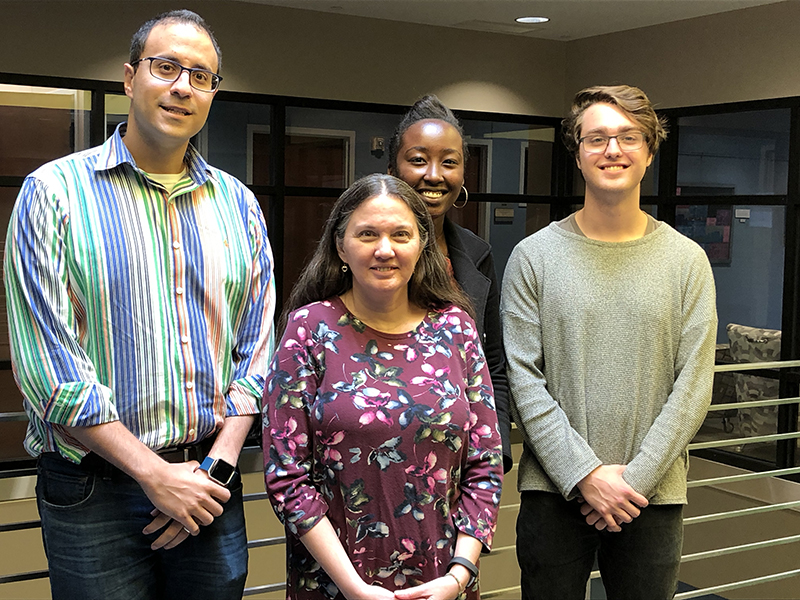

Miami researchers study factors affecting truck driver alertness
Data can help improve safety outcomes, predict worker fatigue

The project uses data from J.B. Hunt trucks and more than 12,000 truck drivers. Pictured above are Fadel Megahed, Karen Davis, Alison Tuiyott and Lucas Harris. Watch a video explaining the study.
By Carole Johnson, university news and communications
Fadel Megahed wants to know when a worker becomes fatigued and what’s the best way to intervene.
He’s leading a team of researchers, including two undergraduate students, in a project looking specifically at truck drivers.
Software engineering and analytics student Lucas Harris' grandfather was a trucker driver.
“My grandfather was a
The study, The Grant Opportunity for Academic Liaison with Industry (GOALI) project, incorporates analytical tools for modeling truck driver’s safety.
Megahed, assistant professor of information systems and analytics in the Farmer School of Business, is the principal investigator. Karen Davis, associate professor of computer science at Miami, is co-investigator. Alex Vinel of Auburn University and Steve Rigdon of Saint Louis University also are involved in the study.
The project uses data from about 12,000 trucks from J.B. Hunt Transport Services, Inc., and 12,000 to 15,000 truck drivers.
Harris is one of two Miami undergraduates receiving additional funding for their research by the National Science Foundation. The other student is Alison Tuiyott, a statistics and analytics co-major with a minor in computer science. The students are formatting J.B. Hunt’s massive data sources into an easily accessible format for statistical analyses.
Data pinpoints issues relating to fatigue and more
For the

Undergraduates Alison Tuiyott and Lucas Harris received funding from the National Science Foundation to work on the study. Watch Tuiyott and Harris explain their involvement in the study.
The goal is to use the
The project began as a collaboration between Auburn University and Saint Louis University and has been supplemented by Megahed’s team, including the undergraduates.
“I think the standard is going to be being able to monitor fatigue on the individual level,” Megahed said. “The alternative is doing nothing or reacting only once an accident or incident or injury happens. So, we’re really trying to come up with a more proactive framework, and that’s the motivation behind all this research.”
Research questions raise tricky solutions
The question of how to most effectively intervene with a fatigued worker is trickier than actually finding when the worker becomes fatigued. Sensory data can pinpoint fatigue. But taking that to the next level of specializing interventions is the ultimate goal.
Megahed added, “We really need to be thinking about: Can we essentially tailor our safety procedures to the individual rather than trying to do it on the population overall? Can we use
Advancing safety through sensor technology
Megahed has dedicated ten years to the study of workplace safety. It all began while
He recruited Lora Cavuoto, an ergonomic specialist and associate professor of industrial and systems engineering at the University at Buffalo, to work together. Their proposals to the American Society of Safety Professionals got them $300,000 to work on the project, with Cavuoto as principal investigator.
The study, Advancing Safety Surveillance Using Individualized Sensor Technology, had the goal of improving safety outcomes in the workplace by merging data. Megahed’s team was able to determine when an individual became fatigued based on observing their gait, using just a single sensor. Ten journal and conference papers were written on the findings.
Studies lead to more questions
What’s next for Megahed’s research?
His main goal for the next five years is to utilize the technologies his team developed by implementing them in the field. He hopes to have a platform where he can share best practices for industry safety. The data is now being analyzed with the project with J. B. Hunt to continue into 2020.
“A lot of companies tend to have a really open mind about sharing safety best practices across their industry, and this is something that we think our work should promote,” he said. “We’re not trying to help the company make a new manufacturing process, we’re looking at how can we better manage the worker’s fatigue to reduce the likelihood of a negative safety outcome.”
Brady Easterling, university news and communications intern, contributed to this story
